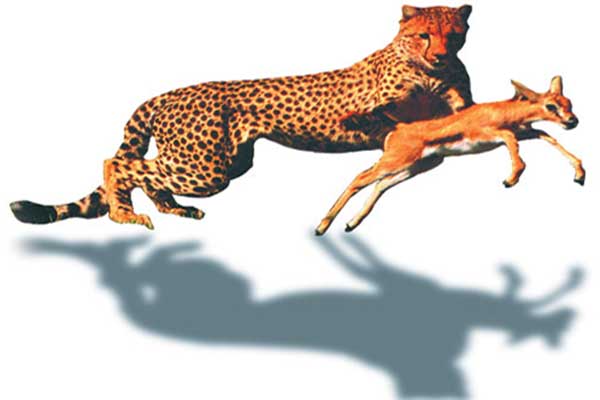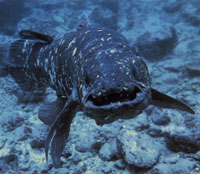The theory of evolution claims that unconscious, unreasoning, inanimate atoms such as phosphorus and carbon assembled themselves together by chance. As a result of such natural phenomena as lightning, volcanic eruptions, ultraviolet rays and radiation, these atoms organized themselves in such a flawless way as to give rise to proteins, cells—and thereafter, fish, rabbits, lions, birds, human beings and all manner of life forms.
That is the basic claim made by the theory of evolution, which regards chance as a creative deity. However, belief in any such claim is a violation of reason, logic and science.
 |
One of evolutionists’ greatest errors is to think that life could have formed spontaneously in the environment they refer to as “the primeval Earth.” |
The theory of evolution maintains that those living organisms that best adapt to their environment have more opportunities to survive and multiply, and therefore, they can pass on their advantageous characteristics to subsequent generations, and species evolve by way of this “mechanism.”
But the fact is that the mechanism in question—known as natural selection—cannot cause living things to evolve, nor endow them with any new features. It can only reinforce existing characteristics belonging to a particular species.
In any given region, for example, those rabbits able to run fastest will survive, while others die. After a few generations, all the rabbits in this region will consist of fast-running individuals. However, these rabbits can never evolve into another species—greyhounds or foxes, for instance.
 |
The youngster being attacked by the cheetah will in all likelihood be unable to escape. Because the cheetah is more agile, powerful and experienced than he is. Evolutionists want to have people believe that this phenomenon, familiar to everyone, is an “evolutionary mechanism.” Yet it is clear that no matter how much time goes by, this youngster will never turn into any other living organism. |
Of all the supposed “proofs” of the theory of evolution, the most frequently repeated concerns changes in a species of moth in 19th century Britain. It is claimed that due to air pollution during the Industrial Revolution, tree bark was darkened—for which reason dark- colored moths were better camouflaged from predatory birds, and thus their numbers increased.
But this is not evolution, because no new species of moth emerged. All that happened was that the ratio ratio of the two already existing types in an already existing species changed. In addition, it has since emerged that the account on which this claim was based was untrue. The well-known photos showing moths clinging to the bark of trees were found to be fabrications. Contrary to what has been claimed, no instance of so-called “industrial melanism”—the darkening of color due to industrial pollution—has ever taken place.
Mutations are caused by random changes in the DNA in which all the information concerning the human body’s characteristics is encoded. Mutations occur due to outside agents such as radiation or chemicals. Evolutionists maintain that such random genetic changes can cause living things to evolve. The fact is, though, that mutations are always harmful to living things, do not develop them, and can never endow them with any new functional features (such as wings or lungs, for instance). Mutations either kill or deform the afflicted organism. To claim that mutations improve a species and endow it with new advantages is like claiming that an earthquake can make a city more advanced and modern, or that striking a computer with a hammer will result in a more advanced model. Indeed, no mutation has ever been observed to increase—much less improve—genetic information.
 |
The erroneous theory known as “spontaneous generation,” which had been around since at least the Middle Ages, maintained that inanimate substances could by chance assamble to produce a living being. The idea that insects formed from food wastes or mice from wheat was widespread up, until the 18th century. Even in the 19th century, when Darwin wrote his book The Origin of Species, the scientific world still widely believed that bacteria could arise from inanimate matter.
In fact, however, only five years after Darwin published his book, Louis Pasteur announced his results after long studies and experiments, that disproved spontaneous generation, a cornerstone of Darwin's theory. In his triumphal lecture at the Sorbonne in 1864, Pasteur said: "Never will the doctrine of spontaneous generation recover from the mortal blow struck by this simple experiment." (Sidney Fox, Klaus Dose, Molecular Evolution and The Origin of Life, New York: Marcel Dekker, 1977. p. 2)
His findings revealed, once again, that life did not emerge spontaneously on Earth, but that it began with a miraculous creation.
The theory of evolution claims that the transition from one species to another takes place from the primitive (simple) to the more complex—progressively, and in stages. According to this claim, bizarre, monstrous creatures known as “transitional forms” must have existed during this progress from one species to another. For example, there must have existed half-fish and half-amphibian creatures that, despite still having fish characteristics, had also acquired some amphibious ones, as well as half-human, half-ape creatures, and half-reptile, half-bird life forms.
If any such transitional species had really existed, then their remains should be encountered in the fossil record. But in over a century, there is still not the slightest trace of such intermediate forms that paleontologists have searched for with such great eagerness.
Almost all the basic living categories known today emerged suddenly and at the same time, during the Cambrian Period, 530 to 520 million years ago. Living organisms with totally different bodily structures—sponges, mollusks, worms, Echinodermata, arthropods and vertebrates—all appeared suddenly, simultaneously, with no life forms remotely resembling them in any earlier geological period. This fact alone completely undermines evolutionists’ claims that living things evolved from a single common ancestor gradually, and over a very long period of time.
The fact that the Earth was suddenly filled with a great many species, all possessing radically different physical structures and exceedingly complex organs demonstrates that these were, of course, created. Since evolutionists deny creation and the existence of God, they cannot definitely explain this miraculous phenomenon.
 |
Just as silica, the raw material of glass, can not gradually transform itself into a crystal goblet, or the pieces of plastic and metal and glass cannot come together and assemble themselves into a camera, neither can living beings come into being from non-living substances—no matter how much time we allow for this to happen. |
Had evolution actually taken place, then living things must have emerged on Earth as a result of small, gradual changes—and to have continued changing over the course of time. Yet the fossil records demonstrate the exact opposite! Different classes of living creatures emerged suddenly, with no ancestors even remotely resembling them, and remained in a stable state, undergoing no changes at all, often for hundreds of millions of years.
 |
Cœlacanth |
Evolutionists used to depict the Cœlecanth, a fish known only from fossils dating back 400 million years, as very powerful evidence of a transitional form between fish and amphibians. Since it was assumed that this species had become extinct 70 million years ago, evolutionists engaged in all kinds of speculation regarding the fossils. On 22 December 1938, however, a living Cœlecanth was caught in the deep waters of the Indian Ocean. More than 200 other living specimens have been caught in the years that followed.
All the speculation regarding these fish had been unfounded. Contrary to what evolutionists claimed, the Cœlecanth was not a vertebrate with half-fish, half-amphibian characteristics preparing to emerge onto dry land. It was in fact a bottom-dwelling fish that almost never rose above a depth of 180 meters (590 feet). Moreover, there were no anatomical differences between the living Cœlecanth and the 400-million-year-old fossil specimens. This creature had never “evolved” at all.
 |
Evolutionists maintain that birds evolved from reptiles—though this is impossible, and a bird’s wing alone is sufficient to prove this. In order for evolution of the kind claimed to have taken place, a reptile’s forearms would have to have changed into functional wings as the result of mutations taking place in its genes—and quickly! And this is not feasible. First of all, this transitional life form would be unable to fly with only half-developed wings. It would also be deprived of its forearms. That would mean it was essentially deformed and therefore—according to the theory of evolution—would be eliminated.
In order for any bird to fly, its wings had to be fully formed in every detail. The wings should be soundly attached to the chest cavity. The bird would need to have a light skeletal structure allowing it to take off, maintain its balance in the air and move in all directions. Its wing and tail feathers would have to be light, flexible and in aerodynamic proportion to one another. In short, everything would have to operate with a flawless coordination in order to make flight possible. How could this inerrant structure in birds’ bodies have resulted from a succession of random mutations? That question has no answer.